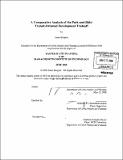| dc.contributor.advisor | Christopher Zegras. | en_US |
| dc.contributor.author | Burgess, Jason (Jason Scott) | en_US |
| dc.contributor.other | Massachusetts Institute of Technology. Dept. of Urban Studies and Planning. | en_US |
| dc.date.accessioned | 2009-01-30T16:37:12Z | |
| dc.date.available | 2009-01-30T16:37:12Z | |
| dc.date.copyright | 2008 | en_US |
| dc.date.issued | 2008 | en_US |
| dc.identifier.uri | http://hdl.handle.net/1721.1/44362 | |
| dc.description | Thesis (M.C.P.)--Massachusetts Institute of Technology, Dept. of Urban Studies and Planning, 2008. | en_US |
| dc.description | Includes bibliographical references (p. [73]-75). | en_US |
| dc.description.abstract | Park-and-ride provided metro regions with a mechanism to reduce commute-generated vehicle-miles traveled, by capturing vehicles in or near their home communities and allowing their drivers to travel to their destinations via transit. The hypothesis underlying this study is that the loss of commuter parking to transit-oriented development involves a tradeoff of one set of benefits (and costs) for another. By assessing the performance of existing park-and-ride facilities, and comparing the associated costs and benefits with those we might expect from transit-oriented development, decision-makers might make land-use decisions that more effectively advance local and regional goals. To that end, this study sets up a methodology to allow for an "apples-to-apples" comparison of the impacts of park-and-ride and transit-oriented development on regional vehicle-miles traveled. This methodology is flexible in its methods and its application, so that it may be adapted to a range of modeling tools and techniques, available data, and regional contexts. Data collected from commuter rail stations in the Boston metro region suggests that park-and-ride performance is more a factor of station distance from commuters' destinations than of the position of a station relative to others on the transit line. This result indicates that redevelopment of park-and-ride facilities in the Boston metro region should focus on cost-inefficient facilities in communities nearer to the CBD, where the benefits of transit-oriented development are also often greater. | en_US |
| dc.description.statementofresponsibility | by Jason Burgess. | en_US |
| dc.format.extent | 75 p. | en_US |
| dc.language.iso | eng | en_US |
| dc.publisher | Massachusetts Institute of Technology | en_US |
| dc.rights | M.I.T. theses are protected by
copyright. They may be viewed from this source for any purpose, but
reproduction or distribution in any format is prohibited without written
permission. See provided URL for inquiries about permission. | en_US |
| dc.rights.uri | http://dspace.mit.edu/handle/1721.1/7582 | en_US |
| dc.subject | Urban Studies and Planning. | en_US |
| dc.title | A comparative analysis of the Park-and-Ride/transit-oriented development tradeoff | en_US |
| dc.type | Thesis | en_US |
| dc.description.degree | M.C.P. | en_US |
| dc.contributor.department | Massachusetts Institute of Technology. Department of Urban Studies and Planning | |
| dc.identifier.oclc | 276867669 | en_US |
